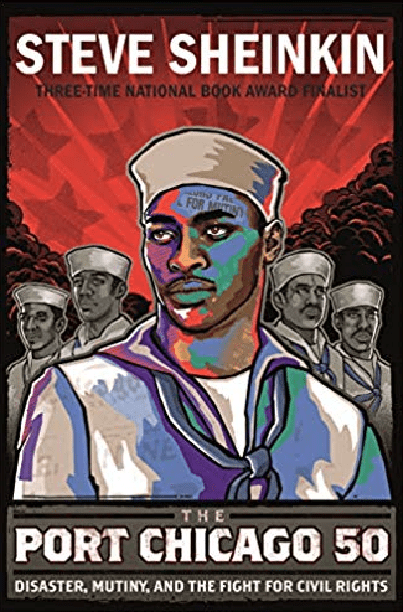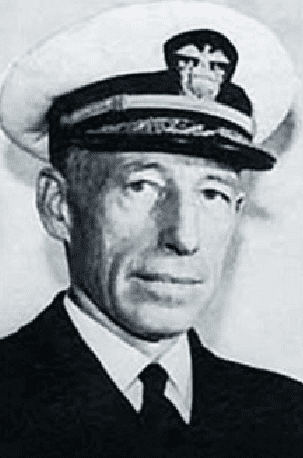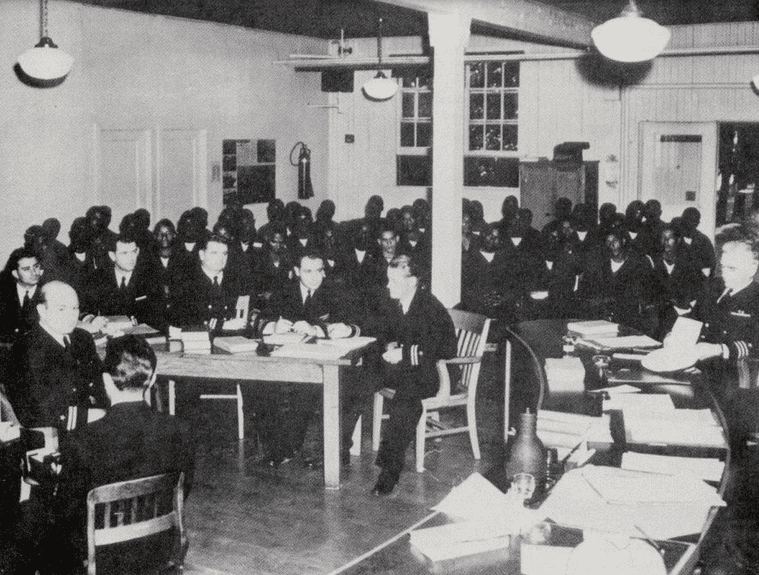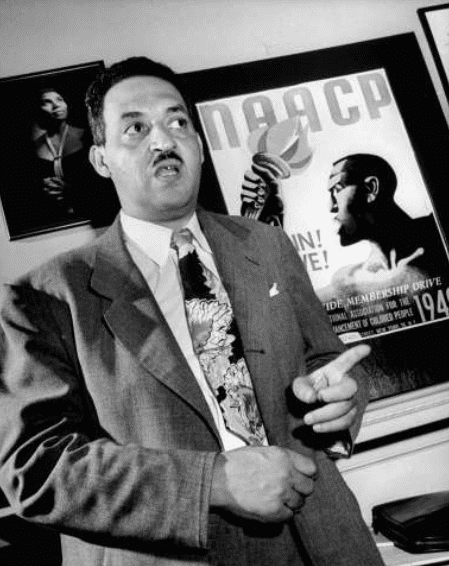By Vernon Case Gauntt
Editor’s Introduction: Earlier this year, we posted a fascinating three-part article written by Vernon Case Gauntt about the remarkable life of his third great aunt, Mary Sawyers Swan, whose life story reads like unbelievable fiction – except every word Vernon (he goes by Casey) wrote was true. (Casey is an accomplished writer. If you enjoy this story, check out his website: Write Me Something Beautiful.)
Now we post another incredible tale from Casey’s family tree, proving once again that truth is stranger than fiction – and that genealogy is endlessly fascinating. Today’s story involves a WWII disaster, when munitions exploded while being loaded on a pier in California on 17 July 1944, killing 320 and wounding another 390. Most of the victims were African American sailors.
Such an important and complicated event requires a bit of story-telling, and so we are presenting the tale of the Port Chicago Disaster in three parts over three days.
Yesterday we posted the first part: Remembering Port Chicago, Part I
Casey’s Introduction: July 17 marks the 75th anniversary of the disaster at Port Chicago in the San Francisco Bay Area of California, when 320 men were killed loading munitions onto two ships bound for the South Pacific. Never heard of Port Chicago, California? Neither had I until this January when my uncle Stan Case, my wife, and I were on a road trip to Willits to meet with the folks who were of immense help to me with the Mary Sawyers story. As we drove over the back bay into San Francisco, my uncle reminisced:
“Back in the 1940s during WWII, my dad’s company, Case Construction, was building a pier in Port Chicago. There was a huge explosion at another pier close by, and a lot of men were killed including, I believe, some Case employees.”
My interest was piqued and I began to do some research. My GenealogyBank subscription came in handy as I found several newspaper articles about the explosion, the Case project, and the resulting fight led by Thurgood Marshall to end the Navy’s policy of strict segregation. Here is that story.
The Navy’s Strict Segregation Policy
Japan’s attack on Pearl Harbor on 7 December 1941 brought the United States into World War II. At that time there were only 5,000 African Americans serving in the entire U.S. Navy. They were restricted to serving on ships as mess attendants. They worked in the kitchens, and cleaned bathrooms and toilets – they were basically servants.
The Navy’s thinking was essentially this: segregation and racism were deeply embedded in American society; whites would not work with blacks, especially in the close confines of a ship, and these weren’t problems for the Navy to solve or experiment with – especially in time of War.
As the need for more men became exacerbated, the Navy made a change to its policy. In the spring of 1942, the Navy began accepting black volunteers for training as sailors. However, they could not become officers and they still could not serve on ships, except as messmen. The black sailors were assigned to land-based jobs the white sailors were loath to do, such as loading ammunition onto ships.

In his thoroughly researched book The Port Chicago 50: Disaster, Mutiny, and the Fight for Civil Rights, Steve Sheinkin painfully describes the discrimination and humiliation suffered by the black sailors at Port Chicago: banned to the backs of buses; barred from all but a handful of establishments; and always under the thumbs of the white officers and Marines guarding the base.
The Port Chicago Disaster brought this all to a head for the surviving sailors. They had signed up, just like white sailors, to give their life – their all – for their country, and yet they had no rights to do so on a battlefield or a battleship.
Aftermath of the Explosion
The official inquiry into the Port Chicago Disaster did not identify a specific cause of the explosions, no doubt hampered by the fact that all possible witnesses were instantly killed. However, it did come out that the officers and sailors on the loading teams had little to no training on how to handle explosives. There were no manuals; no classes. This shocked white civilian stevedores who loaded ships at other ports.
In early August 1944, 328 survivors of the Port Chicago Disaster, excluding the severely wounded, were transferred a few miles north to Mare Island Naval Shipyard on San Pablo Bay in the city of Vallejo, California. The men hadn’t been told what they’d be doing. However, this was another port where ships were loaded with munitions, so they had a pretty good idea.
On August 9, after lunch, the officers assembled the men and began to march them down to the pier where the USS Sangay, a huge, empty ammunition ship, was docked. The men could clearly see rail cars loaded with bombs on the pier. About halfway to the ship, the men stopped in their tracks. No one within their ranks ordered them to do so. They just did.
The officers were infuriated and threatened the men with courts martial and jail for refusing to obey orders. The sailors were separated and interrogated individually. The officers suspected a well-organized, premeditated plan to refuse to load.
Seventy men obeyed the orders to proceed to the pier. The 258 who refused were placed under guard and marched to a barge tied up to the pier which served as a temporary brig.

Two days later, Rear Admiral Carleton H. Wright, Commandant of the Twelfth Naval District, came to Mare Island and addressed the prisoners:
“They tell me that some of you men want to go to sea. I believe that’s a goddamn lie! I don’t believe any of you have the guts to go to sea! I handled ammunition for approximately 30 years, and I’m still here.
“I want to remind you men that mutinous conduct in time of war carries the death sentence, and the hazards of facing a firing squad are far greater than handling ammunition.
“I’m going to let you all know that I personally will recommend the charge of mutiny – and death will be the penalty.”
— from “The Port Chicago Mutiny: The Story of the Largest Mass Mutiny Trial in U. S. Naval History,” by Robert L. Allen
Admiral Wright’s words had the desired effect of scaring the daylights out of many of the sailors, most of whom were in their late teens or early 20s. After hearing the admiral, 208 of the men returned to work loading munitions. Their punishment for initially refusing to obey orders was forfeiture of three months’ pay.
The remaining 50 sailors, who still refused to load munitions, were transferred to Treasure Island in San Francisco Bay to await trial for mutiny.
The Mutiny Trial and a Young NAACP Lawyer
The trial began on September 14. Lieutenant Gerald Veltmann, a 34-year-old lawyer, and four even younger assistants were assigned to represent all 50 defendants. They were given a pitifully brief 30 days to prepare a defense to charges that could result in the death penalty for each man. The Navy prosecutor and his team, the defense team, and the seven high ranking Naval officers serving as judges were all white.

Because of the extremely high profile of the case, extensive press coverage, and entreaties by family members of the accused, the trial came to the attention of a young lawyer making a name for himself in New York City. Thurgood Marshall was 34 and the lead attorney for the National Association for the Advancement of Colored People (NAACP). He would later become the first African American Associate Justice of the Supreme Court of the United States, serving on the Court from 1967 to 1991. But in 1944, he was swamped with civil rights cases spanning the country and, in particular, those involving the discrimination and prejudicial mistreatment of black soldiers and sailors.

In early October, Mr. Marshall sought and obtained the permission of James Forrestal, then Secretary of the Navy, to attend and observe the trial of the Port Chicago 50, as they had come to be known in the press. Although he was not allowed to speak at the trial, Marshall gave daily briefings to the reporters following the case and met regularly with the prisoners.
Marshall was incredulous that, in defense of the men, nothing was being said about the Navy’s unequal treatment of black sailors. He told the NAACP and the press:
“This is not 50 men on trial for mutiny. This is the Navy on trial for its whole vicious policy toward Negroes. Negroes are not afraid of anything more than anyone else. Negroes don’t mind loading ammunition. They just want to know why they were the only ones doing the loading! They want to know why they are segregated, why they don’t get promoted!”
— from People’s World, 17 October 1944
Marshall pleaded with Secretary Forrestal to open an investigation of the Port Chicago Disaster:
“I want to know why, at the time of the explosion at Port Chicago, every man loading ammunition was a Negro. I want to know why sailors were put to work on the loading docks with no training. I want to know why commissioned officers at Port Chicago were allowed to race their men. I want to know why bets ranging from five dollars up were made between division officers as to whose crew would load more ammunition.”
— from People’s World, 17 October 1944
Marshall’s points were not allowed to be admitted at trial. The judges summarily ruled that discrimination and segregation were not relevant or pertinent to the matters before them.
The defense focused on the Navy’s definition of mutiny:
“An unlawful opposition or resistance to or defiance of superior military authority, with a deliberate purpose to usurp, subvert or override such authority.”
Lieutenant Veltmann argued that the prosecution had submitted no credible evidence showing that any man committed a mutinous act; and certainly not all 50. Marshall observed that the only possible offense committed by these men was to disobey an order – no one attempted to take control or override anyone’s authority.
The trial and closing arguments were completed the morning of October 24. After an 80-minute lunch break, the court reconvened and the judges announced their verdict: All 50 men were found guilty of mutiny.
A few days later, the Port Chicago 50 returned to court to hear their sentences. They were the same for each man: 15 years of hard labor in prison, followed by a dishonorable discharge.
To be continued tomorrow…
Note: Casey continues this story on tomorrow’s GenealogyBank Blog. In the meantime, if you’d like to read his first story posted earlier this year, here is that original introduction and links to the three-part article about his third great aunt, Mary Sawyers Swan.
Editor’s Introduction: Here is a story that will interest all kinds of readers. This is a tale brimming with drama, history, and incredible events. And for family historians, this narrative is a vivid reminder that our ancestors’ lives were filled with stories just waiting to be discovered – though perhaps not all as astonishing as this one.
The story of this story began back on 12 September 2017, when we published this article on the GenealogyBank blog: A Fortune Lost at Sea: Ship Sinks with CA Gold Rush Treasure. More than a year later, Vernon (he goes by Casey) Gauntt posted this comment: “My third great aunt, Mary Sawyers Swan, was on that fateful voyage of the SS Central America with her husband, Samuel P. Swan, and their 21-month-old daughter, Martha ‘Lizzie.’”
In a follow-up correspondence, Casey said his aunt had a remarkable life: “This woman finds herself in the middle of some of the greatest events in this country’s history: early pioneer, wagon trains, Indian attacks, Gold Rush, one of the most disastrous ship wrecks of all time, Civil War, fires, San Francisco earthquake, and brushing shoulders with a U.S. President.”
Intrigued, we invited Casey to tell our readers his aunt’s story, which you are about to read. (Casey is an accomplished writer. If you enjoy this story, check out his website: Write Me Something Beautiful.) Such a long and eventful life as Mary’s requires a bit of story-telling, and so we are presenting the tale of Mary Sawyers Swan Cook in three parts over the next three days. Enjoy!
- The True Story of Mary Cook, Part I: Wagon Trains, Gold Rushes, Shipwrecks, Wars, Fires, Earthquakes, Love & More!
- The True Story of Mary Cook, Part II: Wagon Trains, Gold Rushes, Shipwrecks, Wars, Fires, Earthquakes, Love & More!
- The True Story of Mary Cook, Part III: Wagon Trains, Gold Rushes, Shipwrecks, Wars, Fires, Earthquakes, Love & More!
